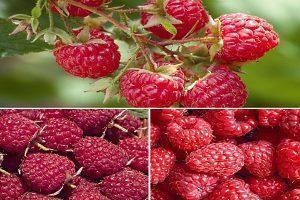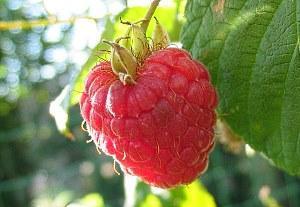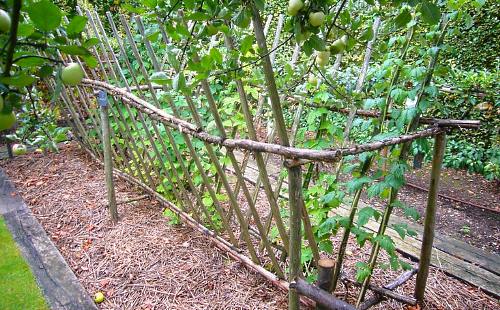Raspberry remontant - planting, growing, care
 A popular variety of raspberries is remontant, which is distinguished by the ability to produce several yields. Remontant raspberry varieties can bring a very large and profitable harvest.
A popular variety of raspberries is remontant, which is distinguished by the ability to produce several yields. Remontant raspberry varieties can bring a very large and profitable harvest.
Growing remontant raspberries - plant features and care
Repaired raspberries are one of the raspberry varieties that are popular in Europe and the CIS due to their unique ability to bear fruit several times per season.
The term "remontant" means "replenishment". In Europe, this type of raspberry is better known under the name "everbearing", which means "bearing fruit continuously."

In addition, the summer harvest of the remontant raspberry variety can significantly worsen and delay the second autumn harvest. This is primarily due to the fact that all the energy will be spent on the first summer harvest. The plant spends most of its energy on the formation of annual stems and shoots that will serve to ripen further crops.
Reproduction of remontant raspberries can be very beneficial for summer residents. Having planted several varieties of raspberries at your dacha, for example, early, mid-late and remontant, you can get several times more harvest and provide your family with delicious berries for the whole year.
Planting remontant raspberries - rules and features
Planting remontant raspberries is a rather laborious process that requires a lot of attention and planning. The specified raspberry variety requires special care, since improper care can cause poor plant development and poor harvest or lack thereof. Before planting plants, you need to find the most comfortable place for this. It is best to give preference to the southern side of the suburban area with a loose and fertile plot of land. However, when planting raspberries of the specified variety, darkened and separated places will not work for you. In such an area, as a rule, the plant will not be able to produce a normal harvest.

Autumn is considered the best time to plant a plant, but if you wish, you can also plant it in summer.
The main thing that needs to be considered when growing remontant raspberries is: planting dates, the depth of planting the seedling in the ground and the density of planting.
Timing - the time for planting remontant raspberries can differ significantly with other varieties. As a rule, this type of plant must be planted at least a week before the designated frost. This variety has a fairly active metabolism, which allows you to get good fruits even during a significant cold snap, but gives some complications when planting new material.
Some gardeners start planting immediately after the last frost and, in most cases, this gives much more results than when planting in a canopy.However, this raises one significant problem - in the first 5 months after such planting, the seedlings will not have time to reach the required maturity and give a normal, large harvest. The first berries with such planting can be obtained only in the second years after planting.
Landing in the ground - as a rule, remontant raspberry plants have a length of up to 250 cm, rather thick stems, but at the same time they have a bunch-type root. This feature allows the plant to receive nutrition only from the depth where the lateral roots are located. That is why it is necessary to plant raspberries of this variety at a depth of 30-50 cm, which will allow the plant to comfortably receive all the substances necessary for nutrition and justify a large area for collecting minerals.
Planting density - when planting raspberries of the specified variety, it is worth considering the height of the bushes and the thickness of the stems. Based on these parameters, the plants should not be planted too close and should not be planted with 2 or more bushes per 1 running meter. Raspberry bushes are not planted every year, but only once in the interval from 7 to 15 years, which is why it is necessary to carefully and carefully consider this procedure so that the plant grows properly and brings a good harvest. Remember that raspberry bushes should not sit too close, because this way it will interfere with their normal growth, and you should take proper care of them.
It is worth noting that when reproducing remontant raspberries, much attention should be paid to fertilization. As a rule, when planting a plant on the bottom of the prepared hole, it is necessary to put compost with the calculation of two buckets per one running meter. You can also use humus and a few glasses. potash fertilizers... If desired, instead of fertilizing, you can use wood ashwhich will also give very good planting and growth results.
The trench must be filled up in layers:
- The first layer contains pre-prepared fertilizers,
- the second is the soil mixed with fertilizers,
- the third is a clean layer of fertile soil.
There are different ways to plant remontant raspberries:
- Ordinary planting method - implies planting in which the distance between the rows of bushes does not exceed 2 meters, when planting seedlings - 1 meter;
- Tape planting - implies planting plants in one or more rows, the gap between which is 0.6 - 0.9 meters.
- Bush planting method - implies planting raspberries with placement in the corners of squares, the sides of which are from 1 to 1.5 meters; with this method, plants are planted at random, choosing the sunniest places for planting.
Pruning remontant raspberries - what to look for
 If you want to get a good and large harvest from remontant raspberries every year, you need to properly care for the plant, and also cut off the shoots every year. If there are also early varieties of raspberries in your summer cottage, then the two-year-old stems of the bushes must be pruned after harvest. Typically, pruning occurs in November and December.
If you want to get a good and large harvest from remontant raspberries every year, you need to properly care for the plant, and also cut off the shoots every year. If there are also early varieties of raspberries in your summer cottage, then the two-year-old stems of the bushes must be pruned after harvest. Typically, pruning occurs in November and December.
If you want to get a rich summer harvest next year, you need to prune all the shoots to ground level.
When pruning remontant raspberries, you must take into account the following rules:
- pruning is done every year 2 times;
- the best times for pruning are November-December and April;
- you should not cut off the tops of the stems, it is from them that fertilization begins;
- pruning is done only when you want to delay the harvest period.
The main mistake of many summer residents is the fact that they start pruning from the tops of the stems. This significantly reduces the yield and the time of its receipt, because it is from the tops that fertilization of the plant begins.
In order to get a rich harvest of high quality, you need to regularly prune remontant raspberries in the spring.Spring pruning involves removing 10-15 cm from the first bud of the plant.
Only those areas of branches and stems that have dried up and frozen over the winter are removed. Pruning of this type is done in early April, a period when early buds are just beginning to appear, swell and it is quite easy to find broken links.
New varieties of remontant raspberries - the best for your garden
It is worth noting that there is a fairly wide variety of different varieties of raspberries. New varieties of remontant raspberries allow you to get a rich harvest of different quality. Before you start planting raspberries, you need to decide which variety you want to plant on your site. Today there are more than 200 different types of remontant raspberries and each of them has its own characteristics and yield.
The most famous are:
 Atlant is a raspberry variety, the bush of which can reach up to 1.75 m in height and is considered quite rare, it practically does not have extra runs, which makes it possible to significantly increase the convenience of harvesting. The bush has small, rare thorns, dark green leaves, large berries;
Atlant is a raspberry variety, the bush of which can reach up to 1.75 m in height and is considered quite rare, it practically does not have extra runs, which makes it possible to significantly increase the convenience of harvesting. The bush has small, rare thorns, dark green leaves, large berries; Perseus is an early variety, has sparse shoots, up to 2 m in height, large dark red berries, one-dimensional, sweet and sour. This variety is considered a simultaneous ripening variety, resistant to dryness and fungus;
Perseus is an early variety, has sparse shoots, up to 2 m in height, large dark red berries, one-dimensional, sweet and sour. This variety is considered a simultaneous ripening variety, resistant to dryness and fungus; The yellow giant is a medium late variety, with dense, powerful shoots, up to 2 m in height, has large yellow berries, one-dimensional, sweet. This variety has an extended ripening process, is characterized by a stable yield, has a high cold resistance;
The yellow giant is a medium late variety, with dense, powerful shoots, up to 2 m in height, has large yellow berries, one-dimensional, sweet. This variety has an extended ripening process, is characterized by a stable yield, has a high cold resistance; Cumberland is a medium late variety, has dense, medium-sized shoots with frequent thorns, small black fruits, round, sweet. A variety of simultaneous ripening, resistant to cold and dryness, to diseases, parasites and temperature changes;
Cumberland is a medium late variety, has dense, medium-sized shoots with frequent thorns, small black fruits, round, sweet. A variety of simultaneous ripening, resistant to cold and dryness, to diseases, parasites and temperature changes; Golden domes are an early variety, with medium-sized, spreading shoots, large berries, bright yellow, conical, sweet and sour. This variety is quite resistant to various diseases, high temperatures, pests, fungal diseases.
Golden domes are an early variety, with medium-sized, spreading shoots, large berries, bright yellow, conical, sweet and sour. This variety is quite resistant to various diseases, high temperatures, pests, fungal diseases. Heritage is a late variety, has large, straight, vigorous shoots, medium-sized berries, bright red, resistant, do not fall off for a long time, round, sweet and sour. This variety is considered one of the highest-yielding varieties, it is quite resistant to diseases and various pests, it does not tolerate cold and dampness.
Heritage is a late variety, has large, straight, vigorous shoots, medium-sized berries, bright red, resistant, do not fall off for a long time, round, sweet and sour. This variety is considered one of the highest-yielding varieties, it is quite resistant to diseases and various pests, it does not tolerate cold and dampness.
GREAT FILM EVERYTHING IS SIMPLE AND PROFITABLE.